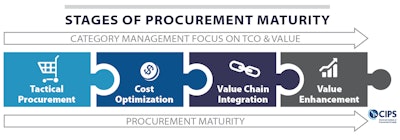
The world’s two largest economies, which had seemed on the brink of resolving all their disputes, collapsed as both the U.S. and China continue to raise tariffs in an all-out trade war. While both sides are continuing to work on trade, the impact is devastating to many companies that were chasing lower labor cost Asia-based supply chains that now represent a significant threat to their business.
The astute procurement professional should have been keenly aware that the supply chains were at extreme risk when President Trump withdrew the United States from the Trans-Pacific Partnership (TPP) in 2017. The TPP was set to become the world’s largest free trade deal, covering 40 percent of the global economy. The organization driven by the chief procurement officer must continuously monitor the economy, global supply markets and the political environments where they operate.
Read Next: The Case for Blockchain in the Healthcare Supply Chain
Many industries are facing disruptive innovation like ride-share firms Uber and Lyft, Dollar Shave Club, electric cars and self-driving cars from competition outside the industry. While many of the examples represent macroeconomic shifts and major disruptions, everyone has opportunities to build a strategic procurement plan aligned to the strategic business plan, and strategic category management that aligns with the procurement and strategic plan. The strategies must be flexible, and the leaders of purchasing must assure business agility when executing the strategic direction.
Building a Procurement Strategy
The procurement strategy is the plan that identifies how to maximize value for the company in both the short- and long-term perspective. The approach allows the organization to consider longer-term goals, such as achieving and maintaining highly competitive supply chains which are architected through effective supplier selections and managed through leading supplier relationship management processes. The documentation of the procurement strategy also aligns all of the organization’s stakeholders around value for money, continuous improvement and drive for innovation.

To build and implement a procurement strategy it is helpful if the procurement team develops a structured analysis around benchmarks, baselines, market analysis and the business plan to determine a future context and internal and external challenges that the organization is facing over the next three to five years. Once the analysis is complete, the team must determine a direction, mission and vision to drive the direction of procurement. It is also necessary to consider corporate culture, other initiatives, core values and actionable levers to assure success.
The ability to monitor the plan, build in key performance indicators and create a communication plan will ultimately drive the success of the strategy. Other considerations while evaluating your existing or future program are cost and value leadership, growth, skills, globalization, corporate social responsibility, risk management, technological changes, and efficiency/complexity reduction.
The chart above outlines the areas impacting stakeholders and provides the basis for building effective strategies. The challenge for the CPO is moving from impact areas to actionable strategies to deploy the strategy. The box below includes examples to demonstrate the conversion of goals to implementable strategies.
By developing action-oriented goals that are measurable and achievable, the strategy can be implemented moving the procurement and the business in the direction of the vision for the procurement organization. There are many examples of maturity curves for the procurement area that can be developed from the initial analysis of procurement.
The chart below is one example that can measure the path to value-based procurement. Ultimately the goal of every procurement strategic plan is to move procurement quickly along the procurement maturity curve. The chart is an example of a maturity curve for procurement from a very tactical weak organization to one that enhances and drives value for the organization.
The Procurement Maturity Curve
The tactical phase of procurement maturity represents a tactical approach where the team is focused on transactional activities, operational effectiveness and purchase price. While there is a benefit in driving the operations and maintaining tactical relationships with suppliers, there is minimal value to the overall organization in terms of driving value.

The cost optimization phase of procurement maturity represents one step up where the procurement team actively understands cost drivers and the impact of cost on the bottom line. The focus in the cost optimization is to impact supplier margins, price reductions, cost manage and cash production. The activities in the cost optimization phase are primarily tactical, and the team has not progressed to supplier relationship management. There is some evidence that the organization is moving into some analysis of total cost of ownership (TCO).
Read Next: Emotional Intelligence Key to Successful Procurement Leadership
As procurement evolves through to the value chain integration phase of the maturity curve, we witness strategic sourcing with matured category management embedded across functions. Purchasing is leading business collaboration; most of the expenditure is under the influence of the team and compliance is high. The business values and expects the contribution of procurement and the CPO as part of the senior management executive team. Increasing levels of value are introduced into the business impacting all aspects of the organization including revenue.
When the value enhancement level of the maturity curve is reached, sourcing provides a strategic competitive advantage with a revenue uptick. Things like innovation, speed to market, product innovation and aligned supply chains bring increasing levels of value to the company through architected supply chains that provide a competitive advantage.
Key Considerations
The first step in the development of a strategy is to define the mission of the procurement organization and articulate the vision clearly so that the procurement team and stakeholders precisely understand the direction that the procurement team is going. By analyzing the benchmarks, baselines and maturity curves, it is essential that the procurement team analyze the current state using the research and analysis the team needs to define the future state of the organization.
While it is desirable to move from the tactical phase of the maturity curve to the value enhancement phase, it is a long journey to gain credibility, align stakeholders, change the processes and develop the team. Many things can impact procurement’s progress. Can the business culture absorb significant change? Are the people on your team the right people? Can they be developed? Can you get the management support, budget and resources required? These factors can impact your timeline so consider building time into your strategy.
UPDATE FREQUENTLY
Review the key plan metrics on a quarterly basis, making adjustments as necessary. When there is a need to adjust the plan, it is essential that there is clear communication to the organization’s senior management and key stakeholders. A well-thought-out plan that is presented, approved and implemented will go a long way to building credibility and respect and advancement within your organization.














